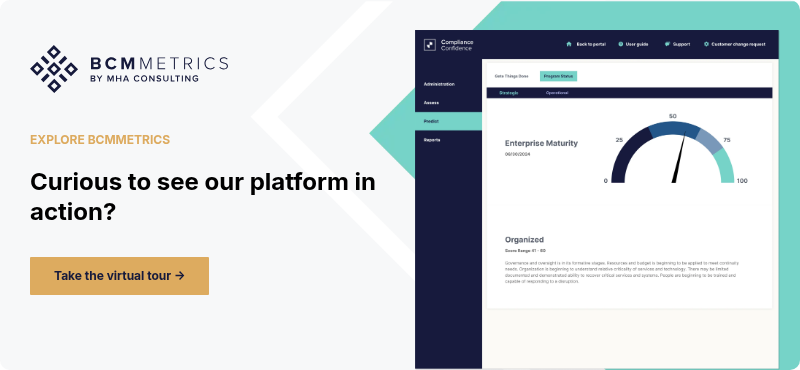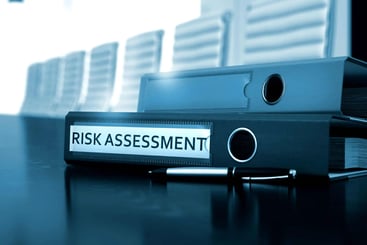Prepare For the Worst with the Best in the Business
Experience capable, consistent, and easy-to-use business continuity management software.
Choosing the right software for business continuity and resilience is more than just ticking boxes. It’s about finding a platform that actually fits the way your team works. From complex governance frameworks to lean BC programs, there’s no shortage of tools offering support for continuity, risk, and crisis management.
Some fall under the broader umbrella of Governance, Risk, and Compliance (GRC) platforms, which aim to unify organizational policies, risk registers, and compliance documentation into a single system. Others are purpose-built for continuity professionals who want to build plans, run BIAs, and stay audit-ready without navigating layers of configuration.
In this post, we compare five widely used platforms: BCMMetrics, Fusion, Noggin, MetricStream, and Riskonnect, and break down who they’re for, what they do best, and what makes them stand out.
Top 5 Operational Resilience Management Tools
Each of these platforms takes a different approach to resilience—some are broad GRC ecosystems. Others are focused tools. Here’s how they compare at a glance platform before we dig into the details:
|
Platform |
Type |
Best for |
Key Strengths |
Notable Features |
|
BCMMetrics |
BC software |
Small-to-mid-sized continuity teams |
Built by consultants, fast to deploy and build a working program |
Compliance assessment, BIA automation, plan builder, facility mapping |
|
Fusion |
GRC platform |
Enterprise orgs using Salesforce |
Highly customizable, strong analyst visibility |
AI Resilience Copilot, scenario simulation, vendor risk management |
|
Noggin |
BC platform |
Emergency-driven teams (e.g., healthcare, infra) |
Real-time coordination, mobile-ready, no-code |
Mobile alerts, drag-and-drop workflows, prebuilt continuity templates |
|
MetricStream |
GRC platform |
Large global orgs with deep compliance needs |
Advanced risk modeling, regulatory tracking |
Monte Carlo simulations, self-assessments, impact tolerance mapping |
|
Riskonnect |
GRC platform |
Teams connecting continuity and enterprise risk |
Broad GRC integration, visual planning tools |
ISO compliance, crisis response, scenario testing, training and audit support |
BCMMetrics
Who is it for?
Small to mid-sized continuity teams that want clarity without complexity. Ideal for highly regulated sectors like healthcare, insurance, finance, and utilities.
Key strengths
Built by business continuity consultants, not generalist developers. BCMMetrics is focused solely on the work continuity teams actually do, without bloated features or steep learning curves. The toolset grows with your program by allowing you to add or remove modules as needed.
Standout features
The Compliance Confidence module helps users assess the maturity of their continuity program with clear scoring and guidance. BIA On-Demand accelerates the impact analysis process, automating calculations for RTOs and other critical metrics.
The BCM Planner module offers a centralized workspace for building, reviewing, approving, exercising, and maintaining plans. At the same time, its BCM One module organizes your facilities on a global map with their continuity plans. Plus, it provides an incident response feature to deal with a disruption.
Fusion Risk Management
Who is it for?
Large enterprises with sophisticated risk, continuity, and third-party management requirements—especially those with internal Salesforce capabilities.
Key strengths
A highly flexible platform that unifies resilience, recovery, and risk within a Salesforce-native environment. Strong analyst recognition (e.g., Gartner MQ) and enterprise integrations.
Standout features
- Scenario simulation and stress testing
- AI-powered Resilience Copilot for plan analysis
- Integration with Salesforce ecosystem
- Vendor and third-party risk modules
Noggin
Who is it for?
Organizations that need real-time coordination during disruptions—such as healthcare, aviation, critical infrastructure, and government.
Key strengths
Combines continuity, emergency response, and safety into one platform. Built for speed, mobility, and hands-on teams without technical support.
Standout features
- Mobile app for alerts and coordination
- No-code drag-and-drop workflow builder
- Incident management dashboard
- Extensive template library
MetricStream
Who is it for?
Large global companies with multi-jurisdiction compliance needs—especially in finance, energy, and healthcare.
Key strengths
One of the most robust GRC tools available. Built for organizations needing deep regulatory tracking, complex risk modeling, and broad policy enforcement.
Standout features
- Monte Carlo risk simulations
- Continuous self-assessments
- Service dependency and impact tolerance mapping
- Integrated compliance and audit trail
Riskonnect
Who is it for?
Companies looking to consolidate business continuity with broader risk and compliance frameworks, especially mid-to-enterprise size organizations.
Key strengths
Riskonnect bridges BC with broader enterprise risk, making it ideal for companies that want fewer platforms and more integration across risk functions.
Standout features
- Emergency notification and crisis management
- Scenario testing and ISO-aligned compliance
- Dependency visualization
- Built-in audit and training tools
Which Tool Is Right for You? Use This Decision Guide
If your team has three or fewer people and you're currently working out of spreadsheets or Word documents, BCMMetrics is likely the strongest fit. It’s designed for smaller teams that need to move quickly, get organized, quickly build their continuity program and show compliance without getting lost in platform configuration.
Organizations that need to exit Word or spreadsheet chaos but don’t want to jump into a heavy GRC suite will benefit from BCMMetrics' simplicity and speed. It’s also a good choice if you lack a dedicated IT admin or don’t want to go through lengthy implementation processes.
On the other hand, if your organization already has a mature GRC program, or is looking to integrate continuity planning with broader risk, compliance, and audit workflows, platforms like MetricStream or Riskonnect may be a better fit. These systems require more coordination but offer deeper integration across departments.
Fusion is a great option for Salesforce-native enterprises that want full flexibility and are prepared to invest in setup and customization. Meanwhile, Noggin is ideal for response-focused teams that need mobile coordination during live events and value real-time workflows over policy documentation.
If your sales cycle is short, your budget is under $100K, and you need fast ROI, BCMMetrics is purpose-built for that kind of team. But if you’re managing multiple jurisdictions, vendor risks, or regulatory frameworks at scale, it may be worth exploring the broader functionality offered by larger GRC platforms.
When BCMMetrics is the Best Choice
If your team is spending more time managing Word documents or spreadsheets than actually planning, BCMMetrics is likely the simpler, more effective way forward. Designed by continuity experts and backed by MHA Consulting’s 25+ years of industry experience, it offers the clarity and practical tools most teams actually need without the overhead.
Ready to see what it looks like in action? Book a short walkthrough to explore how BCMMetrics works.
If you need a compliance-ready, professional continuity program without a steep learning curve or big budget, BCMMetrics is likely your best bet.
It’s focused, practical, and proven, built by people who know what makes a BC program succeed. It doesn’t pretend to do everything. It just works.
So, Which One?
|
Platform |
Best for |
Why it might not fit |
|
Fusion |
Enterprises with deep IT and risk needs |
Complex, expensive, Salesforce-based |
|
Noggin |
Teams managing real-time emergencies |
More than BC teams typically require |
|
MetricStream |
GRC-heavy, global companies |
Requires enterprise-wide coordination |
|
Riskonnect |
Broad risk-first organizations |
Overkill for BC-focused teams |
|
BCMMetrics |
Continuity teams that want to just get it done |
Focused on BC, not full GRC |
Next Step: See BCMMetrics in Action
If BCMMetrics sounds like a fit for your team, the best way to evaluate it is to see it in context.
Whether you're starting from scratch or replacing a spreadsheet-based program, a short walkthrough can show you how it works—and how it can work for you. Book a free demo here!

Michael Herrera
Michael Herrera is the Chief Executive Officer (CEO) of MHA. In his role, Michael provides global leadership to the entire set of industry practices and horizontal capabilities within MHA. Under his leadership, MHA has become a leading provider of Business Continuity and Disaster Recovery services to organizations on a global level. He is also the founder of BCMMETRICS, a leading cloud based tool designed to assess business continuity compliance and residual risk. Michael is a well-known and sought after speaker on Business Continuity issues at local and national contingency planner chapter meetings and conferences. Prior to founding MHA, he was a Regional VP for Bank of America, where he was responsible for Business Continuity across the southwest region.
.png)
.png)




